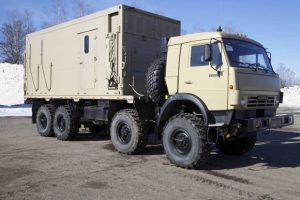
Nine Il-76 military transport aircraft from Chkalovsky Airport will be involved in the operation. They will move nearly 100 virologists and epidemiologists, and eight medical teams with dozens of pieces of equipment to provide assistance in combating the coronavirus (COVID-19) to an airbase of the Italian Air Force near Rome. … The Russian COVID-19 response team includes viral agent defense experts that fought against anthrax and African plague.
A CLOSER LOOK AT RUSSIA’S MOBILE BIOLOGICAL LABORATORY, DEPLOYED TO ITALY
SOUTHFRONT
On March 23 and 24, Russia sent 14 IL-76 military transport planes to Italy, with medical experts, virologists and equipment to aid in the fight against COVID-19.
The personnel and equipment sent to Italy are part of the Nuclear, Biological and Chemical Protection Troops of the Russian Armed Forces. They are special forces designed to conduct the most complex set of measures aimed at reducing the loss of associations and formations of the Ground Forces and ensuring their combat tasks assigned during operations in conditions of radioactive, chemical and biological contamination, as well as at enhancing their survivability and protection against high-precision and other weapons.
The basis of these troops is realized by multifunctional separate brigades, having in their composition sub-units capable of performing all activities. Their tasks include:
- identification and assessment of radiological, chemical and biological environment, scales and effects of damages of objects hazardous radiatively, chemically and biologically;
- protection of formations and units against the nuclear effects of mass destruction weapons and radiological, chemical and biological contamination;
- reducing the visibility of troops and facilities;
- disaster (damage) recovery in objects hazardous radiatively, chemically and biologically;
- causing loss to the enemy by using flame-incendiary means.
The videos of the loading and unloading of the IL-76 provide a glimpse of what exactly was being sent to Italy.
The above photograph shows the Supotnitskiy M.V. Multifunctional Mobile Module Complex for Analysis of Pathogenic Biological Materials (Agents).
It is a multifunctional mobile module complex for analysis of pathogenic biological materials (agents) (MKA PBA) and for the support of the decisions of the operational groups of the Ministry of Defense of Russia in case of biological emergencies.
It has been developed within the framework of the federal target program, “The National System of Chemical and Biological Security of the Russian Federation (2009-2013)”.
The developer is OAO “NPO “Transkom» (PJSC «Research and Production Association “Transkom”) together with the federal state budgetary establishment “48 Central Scientific Research Institute” of the Ministry of Defence of the Russian Federation.
The complex provides life support for the crew during 14 days and nights of autonomous work. The equipment of the complex allows it to identify up to 25 agents of infectious diseases: plague, anthrax, glanders, melioidosis, cholera, typhoid, brucellosis, legionellosis, tularemia, orthopoxvirus diseases, Q fever, rabies, Rift Valley fever, Venezuelan equine encephalitis, Marburg fever, Ebola fever, Lassa fever, Machupo fever, West Niles fever, epidemic nephritis, Crimean-Congo hemorrhagic fever, Dengue haemorrhagic fever, yellow fever, Japanese encephalitis and tick-borne encephalitis.
In case of the absence of any stationary operational bases, MKA PBA can provide the fulfilling sanitary-epidemiological requirements SP 1.3.3118-13 “Security work with microorganisms I-II pathogenicity groups (hazard)”.
The complex can reveal pathogenic biological agents in no less than 20 samples simultaneously with a probability of 0.95. The duration of the preliminary analysis and the evaluation of biological environment in the emergency zone is no less than 15 minutes. The alleged service life of the complex is 12 years.
The complex consists of four components (as can be seen on the photographs) and provides for the identification, identification and genetic typing of pathogens of especially dangerous and dangerous infectious diseases.
The four components are as follows:
- MIFA enzyme immunoassay module
Its purpose is carrying out sample preparation, preliminary express analysis of biological samples and samples from environmental objects, analysis of pathogenic biological agents of pathogenicity groups I-II by ELISA, sample enrichment and safe storage of sample samples in accordance with the requirements of the sanitary rules.
Depending on the task, the MIFA module can perform its functions both as part of the MKA PBA complex and autonomously without loss of effectiveness.
The MIFA module is mounted in a KK6.2 container body on the KamAZ-6350 chassis.
Structurally, the MIFA module consists of four compartments:
- cargo compartment, which houses the means of power supply, ventilation, air conditioning and heating;
- a “clean” compartment for receiving samples, recording and transferring them to a conditionally “infectious” compartment through a transfer gateway for research. In the “clean” compartment there is equipment for controlling and monitoring the operation of power supply, ventilation, and heating systems;
- sanitary inspection room, consisting of a compartment for removing (storing) everyday (working) clothes, a shower cabin and a compartment for dressing in disposable clothes;
- conditionally “infectious” compartment with two workstations for research.
It is possible to operate the MIFA module both with an installation on the ground and from the carrier platform.
The interior of the MIFA module is the following:
- PCR analysis and genotyping module

Its purpose is carrying out sample preparation, preliminary express analysis of biological samples and samples from environmental objects, analysis of BPA I-II pathogenicity groups by PCR in accordance with the requirements of the sanitary rules.
Depending on the task, the module can perform its functions both as part of the MKA PBA complex and autonomously without loss of effectiveness.
The module is mounted in a container body KK6.2 on the KamAZ-6350 chassis.
Structurally, the module consists of four compartments:
- The cargo compartment, which houses the means of power supply, ventilation, air conditioning and heating;
- a “clean” compartment for receiving the samples, their registration and transfer to the conditionally “infectious” compartment through the transfer gateway for research. In the “clean” compartment there is equipment for controlling and monitoring the operation of power supply, ventilation, and heating systems;
- sanitary inspection room, consisting of a compartment for removing (storing) everyday (working) clothes, a shower cabin and a compartment for dressing in disposable clothes;
- conditionally “infectious” compartment with two workstations for research.
It can also be operated with an installation on the ground, and also from the carrier platform.
The PCR interior is the following:
- MOI information processing module

Its purpose is organization of networks of automatic telephone communication, data transmission, radio and satellite communications in the place of deployment of the complex. Carrying out preliminary forecasting and assessment of the biological situation in the emergency area. Collection, synthesis, analysis of information on the biological situation and its transfer to the operational group of the Ministry of Defense of Russia, the command (senior staff) of the headquarters of the emergency response.
Depending on the task, it can operate as part of the MKA PBA complex, or autonomously.
The MOI module can also be used as a mobile control center for the chief of the army of the Russian Armed Forces for the Defense of the Armed Forces of the Russian Federation during the liquidation of biological emergencies.
The MOI interior is the following:
- MBR Biological intelligence vehicle
Its purpose is ensuring the collection and transmission of information about the biological situation. Biological reconnaissance. Selection of biological samples from aerosol and environmental objects. Express analysis of the samples taken by detection methods, ELISA, PCR (electrophoresis) and PCR-RV. Transportation of selected samples to MIFA and PGM modules for their in-depth analysis.
It can also operate autonomously, without being part of the MKA PBA complex.
The MBR vehicle consists of:
- The technological compartment, which houses communications, electricity, ventilation, air conditioning and heating;
- The working compartment, where the equipment for sampling is located, tests for the express detection of the type of pathogen in the native sample by the immunochemical method and PCR, PCR-RV analysis methods, a set of sample analysis tools, a thermocontainer, personal protective equipment, a medical kit, a medical computer, type “ Notebook ”, technical means of disinfecting, transportable stock of disinfectants.
A mobile VHF radio station is located in the driver’s cab to provide communication during movement.
The MBR interior (and not only) can be see below:
Separately, videos show another vehicle – the TMS-65U.
It is a Soviet-era MiG-15 fighter, jet engine-powered special vehicle. TMS-65U is a special disinfection truck with a jet engine mounted in the back, which the Russian military uses to clean vehicles coated in chemical agents or create massive smokescreens to hide friendly movements on the battlefield.
************
Original article

••••
The Liberty Beacon Project is now expanding at a near exponential rate, and for this we are grateful and excited! But we must also be practical. For 7 years we have not asked for any donations, and have built this project with our own funds as we grew. We are now experiencing ever increasing growing pains due to the large number of websites and projects we represent. So we have just installed donation buttons on our websites and ask that you consider this when you visit them. Nothing is too small. We thank you for all your support and your considerations … (TLB)
••••
Comment Policy: As a privately owned web site, we reserve the right to remove comments that contain spam, advertising, vulgarity, threats of violence, racism, or personal/abusive attacks on other users. This also applies to trolling, the use of more than one alias, or just intentional mischief. Enforcement of this policy is at the discretion of this websites administrators. Repeat offenders may be blocked or permanently banned without prior warning.
••••
Disclaimer: TLB websites contain copyrighted material the use of which has not always been specifically authorized by the copyright owner. We are making such material available to our readers under the provisions of “fair use” in an effort to advance a better understanding of political, health, economic and social issues. The material on this site is distributed without profit to those who have expressed a prior interest in receiving it for research and educational purposes. If you wish to use copyrighted material for purposes other than “fair use” you must request permission from the copyright owner.
••••
Disclaimer: The information and opinions shared are for informational purposes only including, but not limited to, text, graphics, images and other material are not intended as medical advice or instruction. Nothing mentioned is intended to be a substitute for professional medical advice, diagnosis or treatment.






















